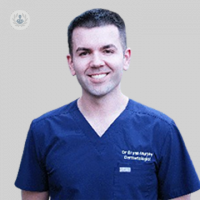Understanding moles: what you need to know
Written by:Moles, which are small pigmented spots on your skin, are a common concern for many individuals. While most moles are harmless, some may require attention. Specialist consultant dermatologist Dr Bryan Murphy explains the various types of moles, how to monitor them and when to seek medical advice.

What Are Moles?
Moles, medically known as naevi, are clusters of pigmented cells that appear as dark, and sometimes skin coloured, spots on the skin. They can vary in size, shape, and colour, ranging from pale pink, to light brown to black. Moles can develop anywhere on the body and are usually harmless.
What are the different types of moles?
There are different types of moles, including:
Common moles
These are typically small, round, and evenly pigmented. They usually develop during childhood and adolescence and are often found on areas exposed to the sun. There are various subtypes including compound moles which are usually raised and brown and intradermal moles which are pink/skin-coloured and raised; both of these types can have hairs growing from them.
Some people have flat moles, which are sometimes referred to as junctional moles. Rarer benign types include red or very dark ‘Spitz’ moles which are usually removed due to their appearance.
Atypical moles
Also known as dysplastic naevi, these moles look abnormal, perhaps with irregular borders and uneven colouring. However, they are not cancerous. While most atypical/dysplastic moles are benign, some may turn into a skin cancer called melanoma, but most do not. People who have dysplastic mole syndrome (over 50 dysplastic moles) might develop a melanoma over their lifetimemoles.
Congenital moles
These moles are present at birth and can vary in size from small to large. Larger congenital moles may have an increased risk of developing into melanoma, a type of skin cancer. It is entirely normal for congenital moles to grow and stretch as a child grows, but if they look odd you should have a dermatologist check it.
When should I seek medical advice for moles?
While most moles are harmless, it is essential to monitor them yourself for any changes that could indicate skin cancer. You should consult a specialist if you notice any concerning changes.
Many patients use the ABCDE rule to check for and identify changes in their moles. This is an alphabetic memory aid listing changes that you should report to your GP or a dermatologist;
- Assymmetry
- Border (irregular)
- Colour (changing or multicoloured)
- Diameter (some list >6mm as concerning, however plenty of normal moles are bigger than this. Growing moles are unusual though, particularly in adults)
- Evolution (worrying change, pain, bleeding, new moles after 30 years old or anything out of the ordinary for your usual moles)
How can I monitor my moles?
Regular self-examination is crucial for detecting any changes in your moles early. I suggest having a look yourself every 4-6 weeks, and enlist the help of a partner, friend or family member if you cannot see your back. It is important to follow these steps when monitoring your moles:
Examine your skin: You should pay close attention to any pigmented lesions or pink/red spots; I encourage patients to take a baseline photograph and store it on their phone; this way every time you check, you can refer back if you are not sure if something is new.
Take note of changes: You should monitor any changes in size, shape, colour, or texture of your moles.
Use the ABCDE rule as listed above
IF IN DOUBT, GET YOUR MOLES CHECKED OUT; If you notice any concerning changes, consult a dermatologist for a thorough evaluation.
Although moles are usually harmless, it is essential to monitor them regularly for any changes that could indicate skin cancer. Furthermore, practising good sun protection and avoiding the use of sunbeds will help to reduce the risk of developing concerning changes in your moles, or skin cancer. Stay vigilant and seek medical advice when necessary.
If you are concerned about moles on your skin and would like to book a consultation with Dr Murphy, do not hesitate to do so by visiting his Top Doctors profile today.


